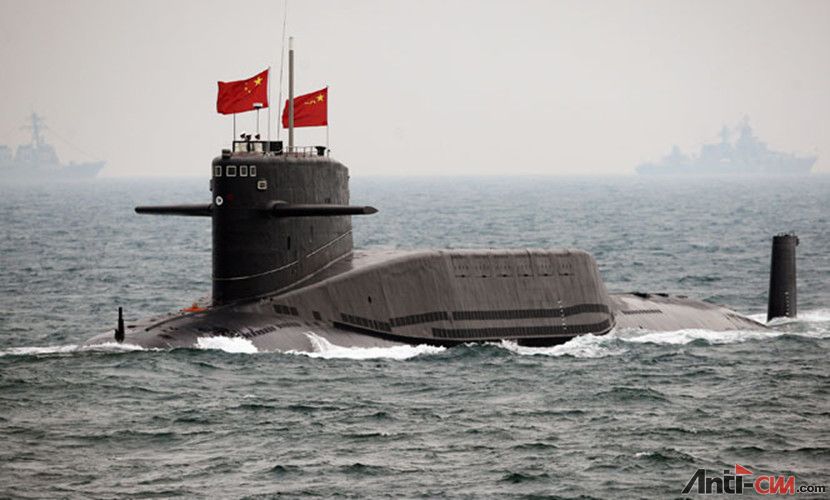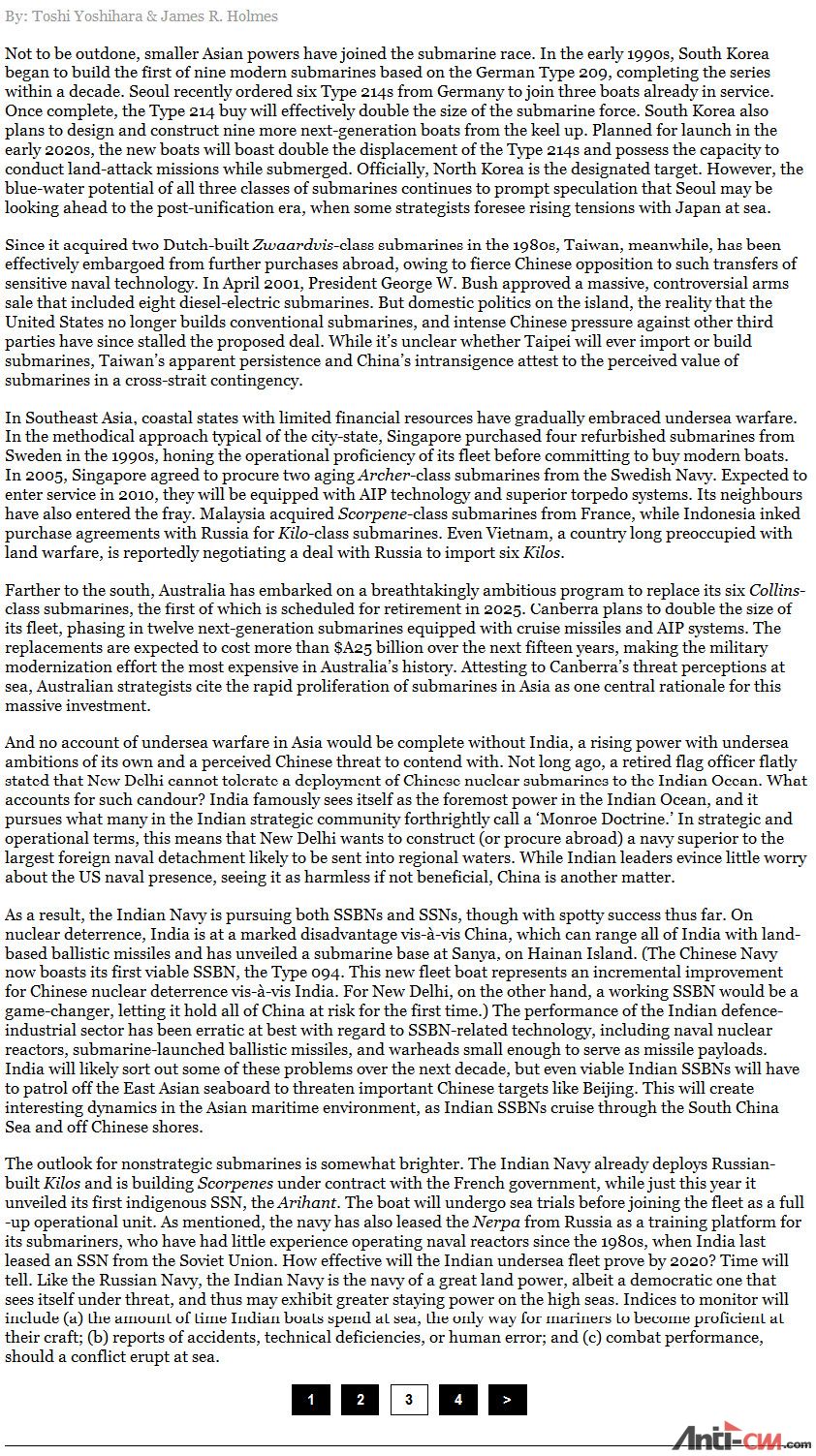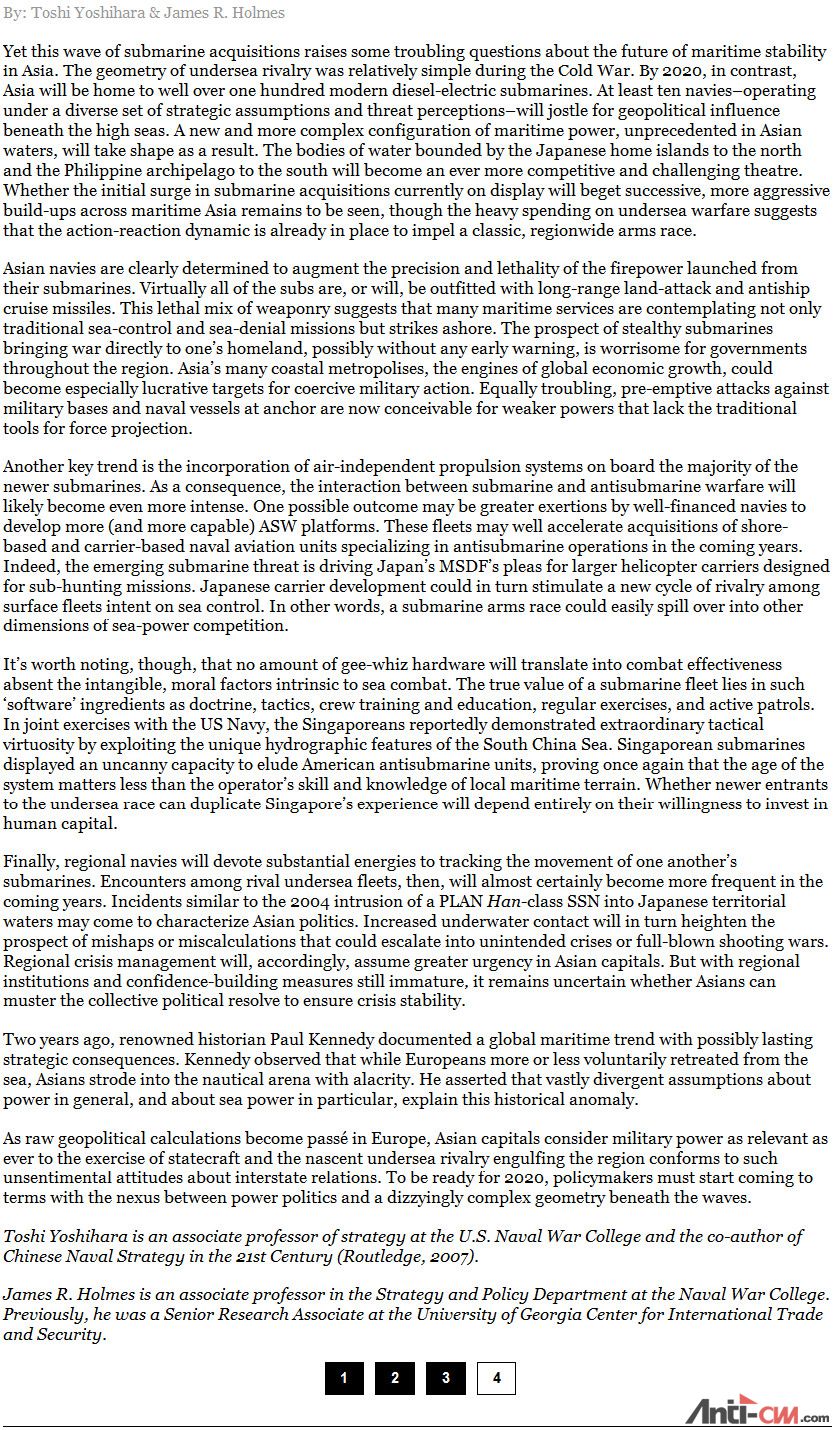|
|
本帖最后由 連長 于 2010-8-8 03:28 编辑
链接:http://apac2020.the-diplomat.com/feature/the-next-arms-race/
作者:
出山吉原(日文: トシ吉原, 英语:Toshi Yoshihara ; 国籍:美国)
詹姆士·R·霍姆斯(James R. Holmes, 国籍:美国)

…will be undersea, say Toshi Yoshihara and James R. Holmes, and will have big political repercussions for the entire Asia-Pacific region.
A naval arms race is gathering pace in the Asia-Pacific. It will be unlike the competition that gripped Europe over a century ago, when the great powers sought to outdo each other in the number and tonnage of warships. Today, a major component of this maritime rivalry is taking place in the murky world of undersea warfare where, instead of the big-gun battleships that became the hallmark of the arms buildup prior to World War I, nations over the next decade will put to sea small, seemingly unassuming submarines.
As a result, neither gun size nor displacement will be accurate measures of sea power. Rather, Asian capitals will invest in the subtleties of hull design, propeller blades and propulsion systems that maximize stealth and endurance for the quiet hunter-killers. Current trends suggest that submarine warfare will emerge as a growth industry in Asia, becoming a defining feature of the regional military balance over the next decade.
So why pursue a submarine program? Essentially, submarines confer operational advantages that appeal to Asian naval planners. The submarine is the ideal platform for sinking merchant shipping and choking off maritime commerce. With most Asian nations dependent on seaborne trade, undersea warfare exploits the acute vulnerabilities of integrated economic systems. The unrestricted submarine warfare undertaken by the German and US navies (against Great Britain and Japan, respectively) during World War II exemplifies the potential of commerce raiding. Submarines also pose an enduring threat to warships. Used defensively, a picket line of subs could erect a no-go zone, effectively denying a hostile naval task force control of the seas. Employed offensively, attack submarines could clear a nautical area of enemy vessels as a prelude to its own exercise of sea control.
Additional strategic factors create further incentives for submarine development. Professional submariners proclaim that the best antisubmarine platform is another submarine. By that logic, navies often feel compelled to compete ‘symmetrically’ with prospective adversaries, matching their submarine build-ups on a one-for-one basis. Submarine competition can thus quickly degenerate into a zero-sum game over numbers, whereby numerical superiority for one side is perceived as a grievous disadvantage for its opponent. And since aircraft-carrier warfare is affordable only to an exclusive club of great powers, submarines offer weaker nations a financially sustainable option for exercising sea power–a capability that would otherwise remain out of reach. It’s unsurprising, then, that a cluster of submarine fleets is taking shape in the region.
The Russian Navy deploys the best-known submarine fleet indigenous to East Asia, if only because it’s the successor to the vaunted Soviet Pacific Fleet. In terms of raw numbers, the Soviet Navy possessed an astonishing undersea fleet–by the early 1970s, some 300 nuclear-powered attack submarines (SSNs) or nuclear guided-missile submarines (SSGNs) were in the Soviet naval inventory, along with 50 nuclear ballistic-missile submarines (SSBNs). For the sake of comparison, the entire US Navy numbered less than 500 vessels by the late 1970s, before the rebuilding effort of the 1980s.
On the other hand, Soviet submarines laboured under a variety of geographic, technical and human constraints. While quantity has a quality all its own, as Fleet Admiral Sergei Gorshkov liked to say (channelling Josef Stalin), numbers are not everything. The northern arc of the ‘first island chain’ encloses the Russian coast in East Asia, offering a hostile submarine force a ready-made defence perimeter. And indeed, Japanese and US antisubmarine forces made expert use of maritime geography. While Soviet boats outshone their Western antagonists in some respects–for example, they were ruggedly built, and thus were able to dive deeper–they were also noisy. As a result, they were relatively easy for Western sonar operators to hear. (One retired US submariner likened the noise levels emitted by early Soviet craft to two skeletons making love inside a metal trash can.)
The din of machinery, then, compromised stealth–the most critical attribute of any submarine. Moreover, the submarine force, like the rest of the Soviet Navy, suffered from a severe deficit in seamanship and skill compared to US and Japanese mariners. Not for nothing did Western submariners boast of how often they bested their Soviet counterparts in the cat-and-mouse game that comprised the Cold War at sea. This same litany of woes persists in the Russian Navy today. To use the three indices posited above, geographic obstacles are permanent. The Russian Pacific Fleet, such as it is, still must contend with an offshore island chain. From a material standpoint, the economic travails that followed the Cold War devastated the Russian navy. In fact, one component of US aid to Russia following the Soviet collapse helped dismantle Soviet nuclear submarines that were rusting pier side. The accidental sinking of the Oscar II-class SSGN Kursk in 2000 and last year’s deadly fire on board the Akula-class attack boat Nerpa–a vessel that was undergoing sea trials before being leased to India–constitute worrisome portents for Moscow.
So, despite the upswing in Russian economic prospects in this era of relatively high oil prices, it’s doubtful that the Russian Navy has yet recovered from the days when Russian sailors were reduced to selling uniform parts for food, as they were on occasion during the 1990s. Morale, engineering proficiency and tactical skill take time to rebuild after such traumas. And the Russian Pacific Fleet is now a shadow of its former self by material measures like numbers and capability. Of the 23 strategic and tactical submarines stationed at Pacific bases, 10 are laid up in reserve, while the material condition of even the active boats is dubious. Capt. Alfred Thayer Mahan, second president of the US Naval War College, wrote that an authoritarian government can create a great navy with impressive speed, but that the fleet could suffer rapid decay should the attention of that government wander. If Mahan is right, Russia will remain a secondary Pacific naval power for the foreseeable future.
Japan’s Maritime Self-Defense Force (MSDF), meanwhile, deploys perhaps the most modern and capable diesel-electric submarine force in the world. Japanese defence planners have kept the fleet at the technological cutting edge by routinely retiring boats well ahead of schedule while introducing ever more capable replacements. Thus, even though the numbers have remained relatively still (at roughly 16 boats) over the past decade, the MSDF has maintained an impressively high proportion of advanced submarines. For example, the latest class of submarines, the Soryu, is superior to its predecessor by virtually every index of performance. The Soryu is the first Japanese boat fitted with air-independent propulsion (AIP), a fuel-cell technology that permits submarines to operate underwater for extended periods while quieting their noise signature. It is a formidable undersea platform. In short, the MSDF leads the region in conventional submarine warfare–constituting the benchmark against which other Asian navies will be compared against over the next decade.
Sea-lane defence occupies a dominant place in Japanese naval thinking. Potential disruptions to seaborne traffic, the lifeblood of the Japanese economy, represent a threat to national survival. One need look no further than the bitter lessons of World War II. During the Pacific War, the US Navy sent over 1,100 Japanese merchantmen to the bottom, reducing the home islands to the brink of mass starvation. At the peak of the Cold War in the 1980s, the Japanese submarine force took up blocking positions along the first island chain, detecting and tracking Soviet submarines that sought access to the Pacific. Many Soviet skippers opted to remain safely within the Sea of Japan rather than run the risk of being sunk in the event of an outbreak of hostilities. Given the economic and strategic imperatives confronting Tokyo, it’s unsurprising that undersea craft rank near the top of Japan’s defence priorities, and will do so for years to come.
The Chinese Navy too boasts a long pedigree in undersea warfare. Swayed by Soviet naval orthodoxy, the People’s Liberation Army Navy (PLAN) devoted virtually all of its attention to coastal defence, a function for which submarines are well suited. Maoist China’s landward orientation and defensiveness at sea reinforced this predilection for undersea combat. Following its quixotic 1950s struggle against Taiwanese and US forces over offshore islands, Beijing transfixed its strategic gaze upon defeating a potential seaborne invasion of the mainland. The submarine force–in conjunction with coastal patrol boats–thus became the first line of homeland defence and an adjunct to army operations. The Chinese naval force structure throughout the Cold War bore witness to this priority and by the 1980s, Beijing had not only put to sea nuclear-powered submarines but also boasted the largest undersea fleet in Asia.
Today, China’s submarine force labours under the weight of this Cold War legacy. The vast majority of the fleet, reverse-engineered from Soviet models of the 1950s and 1960s, is obsolete by Western standards. Yet age is only one measure of effectiveness. A well-placed submarine, even a rickety one, could lie in wait and ambush passing enemy vessels. The 1996 Taiwan Strait crisis, during which President Bill Clinton dispatched two carrier groups as a show of force, is illustrative. As the cross-strait confrontation reached its climax, US defence planners fretted over Beijing’s capacity to deploy much of its undersea fleet to waters near the island. Despite the operational and technological superiority of the US Navy to its Chinese counterpart, American naval commanders nevertheless viewed the potential PLAN deployment with genuine alarm.
Why? US antisubmarine warfare (ASW) is an operational art that atrophied from neglect in the post-Cold War period. ASW remains one of the most demanding missions facing any navy. The burden falls disproportionately on the side that must seek, find and destroy submarines to guarantee an acceptable margin of safety at sea. By contrast, the clever submariner only needs to ensure that a single torpedo reaches a primary target to wreak physical and psychological havoc on the enemy fleet. The asymmetric nature of undersea warfare means that no commander worth his salt takes a submarine threat lightly–however antiquated the enemy boats might be. The sheer number of Chinese submarines magnifies this lopsidedness.
Beijing embarked on a naval modernization program more than a decade ago that is remaking the submarine fleet. In the 1990s, the Chinese purchased two batches of Russian-built Kilo-class diesel-electric submarines armed with deadly wake-homing torpedoes, which seek out the turbulence created by ship propellers and are extraordinarily difficult to evade. Kilos also sport land-attack cruise missiles and antiship cruise missiles. Once thought to be a failing program due to technical difficulties, the indigenous Song-class diesel attack submarine entered serial production early this decade. Attesting to the impressive advances in China’s industrial-military complex, these capable submarines have been built at a rapid pace of two per year. The Yuan-class diesel attack boat made its debut in 2004 to the apparent surprise of the US intelligence community. The Yuan reportedly incorporates the best features of the Kilo and the Song and may even be equipped with indigenously designed air-independent propulsion. The expected entry of the next-generation Shang-class SSNs will add even more striking power to the fleet.
These four classes of modern attack boats already constitute a third of China’s entire undersea force. Over the next decade, as the PLAN commissions new platforms, the majority of its submarines will be modern. In all likelihood, the navy will reverse the steep decline in the overall quantity of its fleet by 2015, as it completes the mass retirement of older hulls. By 2020, then, the fleet will not only be newer but will have made up for the deep cuts in the inventory that began with the end of the Cold War.
Not to be outdone, smaller Asian powers have joined the submarine race. In the early 1990s, South Korea began to build the first of nine modern submarines based on the German Type 209, completing the series within a decade. Seoul recently ordered six Type 214s from Germany to join three boats already in service. Once complete, the Type 214 buy will effectively double the size of the submarine force. South Korea also plans to design and construct nine more next-generation boats from the keel up. Planned for launch in the early 2020s, the new boats will boast double the displacement of the Type 214s and possess the capacity to conduct land-attack missions while submerged. Officially, North Korea is the designated target. However, the blue-water potential of all three classes of submarines continues to prompt speculation that Seoul may be looking ahead to the post-unification era, when some strategists foresee rising tensions with Japan at sea.
Since it acquired two Dutch-built Zwaardvis-class submarines in the 1980s, Taiwan, meanwhile, has been effectively embargoed from further purchases abroad, owing to fierce Chinese opposition to such transfers of sensitive naval technology. In April 2001, President George W. Bush approved a massive, controversial arms sale that included eight diesel-electric submarines. But domestic politics on the island, the reality that the United States no longer builds conventional submarines, and intense Chinese pressure against other third parties have since stalled the proposed deal. While it’s unclear whether Taipei will ever import or build submarines, Taiwan’s apparent persistence and China’s intransigence attest to the perceived value of submarines in a cross-strait contingency.
In Southeast Asia, coastal states with limited financial resources have gradually embraced undersea warfare. In the methodical approach typical of the city-state, Singapore purchased four refurbished submarines from Sweden in the 1990s, honing the operational proficiency of its fleet before committing to buy modern boats. In 2005, Singapore agreed to procure two aging Archer-class submarines from the Swedish Navy. Expected to enter service in 2010, they will be equipped with AIP technology and superior torpedo systems. Its neighbours have also entered the fray. Malaysia acquired Scorpene-class submarines from France, while Indonesia inked purchase agreements with Russia for Kilo-class submarines. Even Vietnam, a country long preoccupied with land warfare, is reportedly negotiating a deal with Russia to import six Kilos.
Farther to the south, Australia has embarked on a breathtakingly ambitious program to replace its six Collins-class submarines, the first of which is scheduled for retirement in 2025. Canberra plans to double the size of its fleet, phasing in twelve next-generation submarines equipped with cruise missiles and AIP systems. The replacements are expected to cost more than $A25 billion over the next fifteen years, making the military modernization effort the most expensive in Australia’s history. Attesting to Canberra’s threat perceptions at sea, Australian strategists cite the rapid proliferation of submarines in Asia as one central rationale for this massive investment.
And no account of undersea warfare in Asia would be complete without India, a rising power with undersea ambitions of its own and a perceived Chinese threat to contend with. Not long ago, a retired flag officer flatly stated that New Delhi cannot tolerate a deployment of Chinese nuclear submarines to the Indian Ocean. What accounts for such candour? India famously sees itself as the foremost power in the Indian Ocean, and it pursues what many in the Indian strategic community forthrightly call a ‘Monroe Doctrine.’ In strategic and operational terms, this means that New Delhi wants to construct (or procure abroad) a navy superior to the largest foreign naval detachment likely to be sent into regional waters. While Indian leaders evince little worry about the US naval presence, seeing it as harmless if not beneficial, China is another matter.
As a result, the Indian Navy is pursuing both SSBNs and SSNs, though with spotty success thus far. On nuclear deterrence, India is at a marked disadvantage vis-à-vis China, which can range all of India with land-based ballistic missiles and has unveiled a submarine base at Sanya, on Hainan Island. (The Chinese Navy now boasts its first viable SSBN, the Type 094. This new fleet boat represents an incremental improvement for Chinese nuclear deterrence vis-à-vis India. For New Delhi, on the other hand, a working SSBN would be a game-changer, letting it hold all of China at risk for the first time.) The performance of the Indian defence-industrial sector has been erratic at best with regard to SSBN-related technology, including naval nuclear reactors, submarine-launched ballistic missiles, and warheads small enough to serve as missile payloads. India will likely sort out some of these problems over the next decade, but even viable Indian SSBNs will have to patrol off the East Asian seaboard to threaten important Chinese targets like Beijing. This will create interesting dynamics in the Asian maritime environment, as Indian SSBNs cruise through the South China Sea and off Chinese shores.
The outlook for nonstrategic submarines is somewhat brighter. The Indian Navy already deploys Russian-built Kilos and is building Scorpenes under contract with the French government, while just this year it unveiled its first indigenous SSN, the Arihant. The boat will undergo sea trials before joining the fleet as a full-up operational unit. As mentioned, the navy has also leased the Nerpa from Russia as a training platform for its submariners, who have had little experience operating naval reactors since the 1980s, when India last leased an SSN from the Soviet Union. How effective will the Indian undersea fleet prove by 2020? Time will tell. Like the Russian Navy, the Indian Navy is the navy of a great land power, albeit a democratic one that sees itself under threat, and thus may exhibit greater staying power on the high seas. Indices to monitor will include (a) the amount of time Indian boats spend at sea, the only way for mariners to become proficient at their craft; (b) reports of accidents, technical deficiencies, or human error; and (c) combat performance, should a conflict erupt at sea.
Yet this wave of submarine acquisitions raises some troubling questions about the future of maritime stability in Asia. The geometry of undersea rivalry was relatively simple during the Cold War. By 2020, in contrast, Asia will be home to well over one hundred modern diesel-electric submarines. At least ten navies–operating under a diverse set of strategic assumptions and threat perceptions–will jostle for geopolitical influence beneath the high seas. A new and more complex configuration of maritime power, unprecedented in Asian waters, will take shape as a result. The bodies of water bounded by the Japanese home islands to the north and the Philippine archipelago to the south will become an ever more competitive and challenging theatre. Whether the initial surge in submarine acquisitions currently on display will beget successive, more aggressive build-ups across maritime Asia remains to be seen, though the heavy spending on undersea warfare suggests that the action-reaction dynamic is already in place to impel a classic, regionwide arms race.
Asian navies are clearly determined to augment the precision and lethality of the firepower launched from their submarines. Virtually all of the subs are, or will, be outfitted with long-range land-attack and antiship cruise missiles. This lethal mix of weaponry suggests that many maritime services are contemplating not only traditional sea-control and sea-denial missions but strikes ashore. The prospect of stealthy submarines bringing war directly to one’s homeland, possibly without any early warning, is worrisome for governments throughout the region. Asia’s many coastal metropolises, the engines of global economic growth, could become especially lucrative targets for coercive military action. Equally troubling, pre-emptive attacks against military bases and naval vessels at anchor are now conceivable for weaker powers that lack the traditional tools for force projection.
Another key trend is the incorporation of air-independent propulsion systems on board the majority of the newer submarines. As a consequence, the interaction between submarine and antisubmarine warfare will likely become even more intense. One possible outcome may be greater exertions by well-financed navies to develop more (and more capable) ASW platforms. These fleets may well accelerate acquisitions of shore-based and carrier-based naval aviation units specializing in antisubmarine operations in the coming years. Indeed, the emerging submarine threat is driving Japan’s MSDF’s pleas for larger helicopter carriers designed for sub-hunting missions. Japanese carrier development could in turn stimulate a new cycle of rivalry among surface fleets intent on sea control. In other words, a submarine arms race could easily spill over into other dimensions of sea-power competition.
It’s worth noting, though, that no amount of gee-whiz hardware will translate into combat effectiveness absent the intangible, moral factors intrinsic to sea combat. The true value of a submarine fleet lies in such ‘software’ ingredients as doctrine, tactics, crew training and education, regular exercises, and active patrols. In joint exercises with the US Navy, the Singaporeans reportedly demonstrated extraordinary tactical virtuosity by exploiting the unique hydrographic features of the South China Sea. Singaporean submarines displayed an uncanny capacity to elude American antisubmarine units, proving once again that the age of the system matters less than the operator’s skill and knowledge of local maritime terrain. Whether newer entrants to the undersea race can duplicate Singapore’s experience will depend entirely on their willingness to invest in human capital.
Finally, regional navies will devote substantial energies to tracking the movement of one another’s submarines. Encounters among rival undersea fleets, then, will almost certainly become more frequent in the coming years. Incidents similar to the 2004 intrusion of a PLAN Han-class SSN into Japanese territorial waters may come to characterize Asian politics. Increased underwater contact will in turn heighten the prospect of mishaps or miscalculations that could escalate into unintended crises or full-blown shooting wars. Regional crisis management will, accordingly, assume greater urgency in Asian capitals. But with regional institutions and confidence-building measures still immature, it remains uncertain whether Asians can muster the collective political resolve to ensure crisis stability.
Two years ago, renowned historian Paul Kennedy documented a global maritime trend with possibly lasting strategic consequences. Kennedy observed that while Europeans more or less voluntarily retreated from the sea, Asians strode into the nautical arena with alacrity. He asserted that vastly divergent assumptions about power in general, and about sea power in particular, explain this historical anomaly.
As raw geopolitical calculations become passé in Europe, Asian capitals consider military power as relevant as ever to the exercise of statecraft and the nascent undersea rivalry engulfing the region conforms to such unsentimental attitudes about interstate relations. To be ready for 2020, policymakers must start coming to terms with the nexus between power politics and a dizzyingly complex geometry beneath the waves.
作者简介:

出山吉原
头衔:Associate ProfessorStrategy & Policy
电话: (401) 841-2185
传真: (401) 841-6418
电邮:toshi.yoshihara@usnwc.edu
简介:Toshi Yoshihara is an associate professor of strategy at the U.S. Naval War College and the co-author of Chinese Naval Strategy in the 21st Century (Routledge, 2007).
详细介绍:http://www.usnwc.edu/Academics/Faculty/Toshi-Yoshihara.aspx

詹姆士·R·霍姆斯
头衔:Associate Professor Strategy & Policy电话: (401) 841-7186
电邮: james.holmes@usnwc.edu
简介:James R. Holmes is an associate professor in the Strategy and Policy Department at the Naval War College. Previously, he was a Senior Research Associate at the University of Georgia Center for International Trade and Security.
详细介绍:http://www.usnwc.edu/Academics/Faculty/James-Holmes.aspx
网页截图:




|
arms, Next, race, The, 军备竞赛, arms, Next, race, The, 军备竞赛, arms, Next, race, The, 军备竞赛
评分
-
1
查看全部评分
-
|